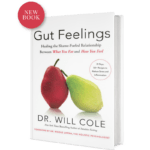Lost Your Taste & Smell After COVID? Here’s How to Get Them Back

As we move through the world, we’re using all of our senses all the time. But sometimes we don’t really notice until one of them weakens— or seems to be lost altogether.
Loss of taste and smell is a common symptom both during and after COVID, and it can be really disconcerting.
While most of us have experienced a temporary change in our ability to smell or taste things while our noses are stuffed up with a common cold, what happens with COVID is different.
This symptom can linger long after others have cleared up, and doesn’t necessarily have an obvious cause (like nasal congestion) that we can feel. I’ve had several COVID-19 patients come in worried that they’ll never get their senses back.
While I can’t make any guarantees, I have found, through both research and clinical experience, a few key strategies that can help you naturally restore your sense of taste and smell.
Loss of Taste and Smell After COVID: An Overview
Research has shown that around 60% of those who develop a SARS-Co-V2 infection (the virus that causes COVID) experience at least some loss of taste and smell— and about a quarter of those patients end up with a long term loss of smell. (1)
Subscribe for Free Access Continue reading our in-depth research and evidence-based protocols by entering your name and email below. We respect your privacy. Unsubscribe anytime. A complete loss of smell is known as anosmia, while a partial loss of smell is called hyposmia. Even though we don’t tend to think of smell as being as “important” a sense as sight or hearing, smell loss can cause a lot of emotional distress and interfere with quality of life. It also directly affects our ability to taste food. Some people also experience alterations to smell and taste, for example finding that everything tastes metallic or salty, or smelling smoke that isn’t actually present (this altered sense of smell is known as parosmia). Before we get into remedies, let’s take a quick look at why loss of taste and smell after a COVID-19 infection might happen. As a functional medicine practitioner, I’m a big believer in the importance of understanding the root cause of any symptoms or dysfunction. When we understand the why, we can work much more effectively with the body to restore function and balance. Researchers have identified a likely mechanism behind anosmia associated with COVID: the coronavirus may indirectly impair olfactory receptors, proteins on the surface of nerve cells in the nose that detect odors. (2) Unlike loss of smell caused by sinus congestion, this is actually a neurological symptom. While the virus hasn’t been shown to directly affect olfactory receptors or nerve cells, the presence of the virus near these neurons and receptors can trigger a significant inflammatory response, releasing cytokines that can in turn impact the genetic expression and activity of olfactory nerve cells. This is an important finding not only for loss of taste and smell but also for other neurological symptoms of long COVID— and likely non-neurological symptoms as well. The most common approach to restoring taste and smell is olfactory retraining, which basically involves exposing yourself to strong smells in order to retrain your brain to recognize and process aromas. I’m going to cover olfactory retraining in a bit more detail below. It’s definitely a worthwhile component of treatment that’s simple, natural, and noninvasive. But keep in mind as well what we just learned about the mechanism behind loss of taste and smell after COVID: it involves excess inflammation and nerve impairment. (3) So for a more thorough approach, we need to address these root causes. And if you’re experiencing other symptoms of long COVID like fatigue or brain fog, you may find that these approaches help you clear those up as well. Reducing systemic or overall inflammation and overactive immune responses is essential for getting long COVID symptoms, including loss of taste and smell, under control. We don’t necessarily need to focus on olfactory inflammation specifically here; we’re actually targeting the immune system. Restoring immune system balance and reducing excess inflammation may help to protect against ongoing damage to neurons and allow nerve cells to regenerate. Following an anti-inflammatory diet and eliminating possible dietary triggers is a core step towards reducing inflammation. Meditation and mindfulness practices, regular moderate exercise, and good quality sleep are other foundational steps. With these core supports in place, you may want to explore anti-inflammatory and immune supportive supplements like glutathione or curcumin. Therapies including hyperbaric oxygen therapy (HBOT) and ozone therapy may also be able to help stimulate natural repair and regeneration. The vagus nerve, the longest nerve in the body, is an essential part of the gut-brain axis and the parasympathetic nervous system. It plays an important role in regulating the stress response and modulating inflammation. There are several natural things you can do to stimulate the vagus nerve to work more effectively, including deep breathing exercises, humming, singing, and gargling. Vagal nerve stimulation may help to reduce long COVID symptoms overall, and a 2025 systematic review published in The American Journal of Medicine suggests that olfactory dysfunction may be one symptom that could benefit. (4, 5) READ MORE: Vagus Nerve Stimulation: Everything You Need To Know + Exactly Why It Matters | Dr. Will Cole Olfactory retraining involves smelling and tasting things with strong aromas. (6) This may include essential oils from peppermint or eucalyptus, foods like lemons, oranges, or peanut butter, or natural perfumes, as a few examples. It’s generally recommended to choose a variety of strong smells with which you have a strong personal association or scent memory. The sooner you get started, the better. The retraining process involves smelling each of your chosen scents (most people recommend 5-10 scents) for 30 seconds to two minutes, and during this time, thinking about what you’re smelling and any memories you associate with the aroma. This process has been shown to help stimulate the functioning of your olfactory system.
Why Does It Happen?
How to Restore Taste and Smell
Reducing Inflammation
Vagus Nerve Stimulation
Olfactory Retraining (Smell Training)
Smell training is sort of akin to behavioral therapy for neurocognitive disorders that are linked to things like inflammation and gut imbalances. We’re trying to retrain an organ to function in a certain way without addressing the thing that is causing its dysfunction. At best, it’s an incomplete solution, but it’s definitely worth a try in combination with the strategies we talked about above.
Acupuncture
A couple of case reports have shown that acupuncture may help to improve loss of smell and taste. (7) Acupuncture may help to improve circulation, restore nerve function, and reduce stress and inflammation, all of which could help with olfactory nerve damage and other symptoms of COVID-19.
READ NEXT: POTS and COVID-19: Is It the Virus or the Vaccine?
Get To the Root Cause of Your Symptoms
By understanding that an excessive inflammatory response is triggering nerve dysfunction associated with loss of taste and smell, you’re much better equipped to tackle the problem.
Aim to combine practices like smell training with root-cause focused treatments that address the whole body to regain your sense of smell (olfaction) and overall well-being.
The best approach is personalized and involves identifying factors that may be making you more susceptible to a COVID-related increased inflammatory response and immune system reactivity. If you’re ready to get started, we’d be happy to help at our functional medicine telehealth clinic.
As one of the first functional medicine telehealth clinics in the world, we provide webcam health consultations for people around the globe.
Start Your Health Journey Today
FUNCTIONAL MEDICINE CONSULTATIONS FOR PEOPLE AROUND THE WORLD
- Mitchell, M. B., Workman, A. D., Rathi, V. K., & Bhattacharyya, N. (2023). Smell and taste loss associated with COVID‐19 infection. The Laryngoscope, 133(9), 2357-2361.
- Zazhytska, M., Kodra, A., Hoagland, D. A., Frere, J., Fullard, J. F., Shayya, H., ... & Lomvardas, S. (2022). Non-cell-autonomous disruption of nuclear architecture as a potential cause of COVID-19-induced anosmia. Cell, 185(6), 1052-1064.
- Ho, C. Y., Salimian, M., Hegert, J., O’Brien, J., Choi, S. G., Ames, H., ... & Drachenberg, C. (2022). Postmortem assessment of olfactory tissue degeneration and microvasculopathy in patients with COVID-19. JAMA neurology, 79(6), 544-553.
- Khan, M. W., Ahmad, M., Qudrat, S., Afridi, F., Khan, N. A., Afridi, Z., ... & Ikram, J. (2024). Vagal nerve stimulation for the management of long COVID symptoms. Infectious Medicine, 100149.
- Markser, A., Vöckel, J., Schneider, A., Baumeister-Lingens, L., Sigrist, C., & Koenig, J. (2024). Non-invasive brain stimulation for post-COVID-19 conditions: A systematic review. The American Journal of Medicine.
- Alarfaj, A. A., Aldrweesh, A. K., Aldoughan, A. F., Alarfaj, S. M., Alabdulqader, F. K., & Alyahya, K. A. (2023). Olfactory dysfunction following COVID-19 and the potential benefits of olfactory training. Journal of Clinical Medicine, 12(14), 4761.
- Morita, A., Murakami, A., Uchihara, T., Ohashi, N., Ryu, K., Watanabe, Y., ... & Namiki, T. (2022). Case Report: Acupuncture is an effective treatment for olfactory dysfunction in the post COVID-19 condition. Frontiers in Neurology, 13, 916944.
The information on this website has not been evaluated by the Food & Drug Administration or any other medical body. We do not aim to diagnose, treat, cure or prevent any illness or disease. Information is shared for educational purposes only. You must consult your doctor before acting on any content on this website, especially if you are pregnant, nursing, taking medication, or have a medical condition.
Our content may include products that have been independently chosen and recommended by Dr. Will Cole and our editors. If you purchase something mentioned in this article, we may earn a small commission.

BY DR. WILL COLE
Dr. Will Cole, DNM, IFMCP, DC is a leading functional medicine expert who consults people around the globe, starting one of the first functional medicine telehealth centers in the world. Named one of the top 50 functional and integrative doctors in the nation, Dr. Will Cole provides a functional medicine approach for thyroid issues, autoimmune conditions, hormonal imbalances, digestive disorders, and brain problems. He is also the host of the popular The Art of Being Well podcast and the New York Times bestselling author of Intuitive Fasting, Ketotarian, Gut Feelings, and The Inflammation Spectrum.

Gut Feelings
Healing The Shame-Fueled Relationship
Between What You Eat And How You Feel
